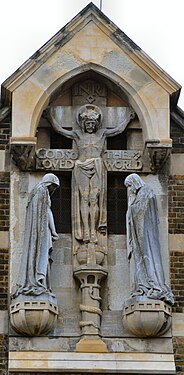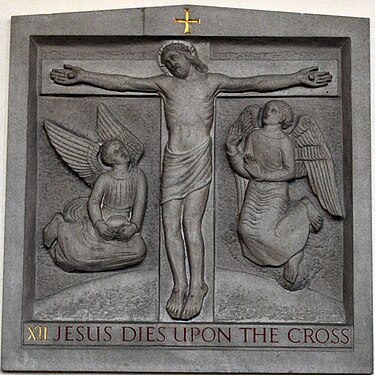St John the Divine, Richmond
| St John the Divine, Richmond | |
|---|---|
 St John the Divine from St John's Road, Richmond | |
 | |
| 51°27′51″N 0°18′01″W / 51.4642°N 0.3003°W | |
| Location | Richmond, London |
| Country | England |
| Denomination | Church of England |
| Website | www |
| History | |
| Founded | 1831 |
| Associated people | Vigo Auguste Demant (vicar from 1933 to 1942) |
| Architecture | |
| Architect(s) | Lewis Vulliamy (original building); Arthur Grove (later additions and church hall) |
| Style | Early Gothic revival |
| Completed | 1836 |
| Administration | |
| Province | Canterbury |
| Diocese | Southwark |
| Episcopal area | Kingston |
| Archdeaconry | Wandsworth |
| Deanery | Richmond & Barnes |
| Parish | St John the Divine, Richmond |
| Clergy | |
| Archbishop | Justin Welby |
| Bishop(s) | Christopher Chessun |
| Vicar(s) | Neil Summers[1] |
| Laity | |
| Reader(s) |
|
| Parish administrator | Liz Roberts[2] |
Listed Building – Grade II | |
| Official name | Church of St John the Divine |
| Designated | 10 January 1950 |
| Reference no. | 1194182 |
St John the Divine, Richmond, in the Anglican Diocese of Southwark, is a Grade II listed church[3] on Kew Road, in Richmond, London, near Richmond railway station. Built in 1836, and a parish in its own right since 1838, it was designed by Lewis Vulliamy[4] in the Early Gothic Revival architectural style.[3]
Since 1996 St John the Divine has been part of the Richmond Team Ministry, which also includes the churches of St Mary Magdalene and St Matthias.[5][6]
History
[edit]Richmond grew rapidly during the 18th and early 19th centuries.[7] By the 1820s, Richmond's original parish church, St Mary Magdalene, was too small.,[8] quoted in Brown, Ingrid (10 September 2011). "St.Matthias' Church and the Medievalism of Sir George Gilbert Scott". The Victoria Web. Retrieved 16 April 2015.</ref> Having recognised the need for another chapel, the vestry commissioned new construction by 1831. The new building, St John the Divine, was completed in 1836.,[9] quoted in Brown, Ingrid (10 September 2011). "St.Matthias' Church and the Medievalism of Sir George Gilbert Scott". The Victoria Web. Retrieved 16 April 2015.</ref> It was built from 1831 to 1836 on a site provided by local resident and landowner, William Selwyn (1775–1855); the architect was Lewis Vulliamy. Bridget Cherry and Nikolaus Pevsner criticise Vulliamy's "craziest W spire and senseless flying buttresses from the W porches up to the nave" but describe Grove's east end (added in the early 20th century) as "a fine composition".[4]
In 1838 it became a parish church in its own right.[10]
Organ
[edit]The organ, built by Beale and Thynne, was dedicated in December 1896.[11] Described as "a virtually unaltered work of Victorian artistry", it has been fully restored.[12]
20th-century additions
[edit]A chancel, south chapel and vestries were added in 1904–1905; they were designed by Arthur Grove.[4] In 1908, Nathaniel Westlake painted the sanctuary ceiling with illustrations of the Book of Revelation, chapter 14, and created the triptych behind the altar.[4][11] Westlake also painted the Stations of the Cross, which are now missing; they were replaced between 1955 and 1970 by reliefs in Nabresina stone carved by Freda Skinner.[4] Eric Gill carved the stonework on the triptych and over the sacristy door.[11][13] The Calvary sculpture on the east end facing St John's Road was carved by Richard Garbe.[14]
The church hall, in brick, was built in 1911.[4]
In 1980–1981 adaptations were made to the church to enable it be used occasionally for concerts and to provide a meeting room, toilet facilities and residential accommodation.[15] The architects were Dry Hastwell Butlin Bicknell,[4] a partnership of David Dry (1934–2011), Vince Hastwell, George Butlin and Roger Bicknell.[16]
21st-century restoration
[edit]The reredos in the Lady Chapel was restored in the early 21st century by Howell and Bellion.[17]
People
[edit]Vigo Auguste Demant (1893–1983), vicar at St John the Divine from 1933 to 1942, became a Canon of St Paul's Cathedral and an Oxford University professor. A regular broadcaster on the BBC's Third Programme in the 1950s,[18] he served on the committee that produced the 1957 Wolfenden report which recommended that "homosexual behaviour between consenting adults in private should no longer be a criminal offence".[19]
Worship
[edit]The church's style of worship is described as "modern/liberal Catholic".[20] Eucharist is celebrated at 11.00 am on Sundays and 7:00 pm on Tuesdays.[21]
Photo gallery
[edit]-
The West façade of the church
-
The spire viewed from above the trees
-
The Sanctuary
-
The Triptych by Nathaniel Westlake
-
The chancel ceiling by Westlake
-
Interior view
-
The recently restored Lady Chapel, restored in the 21st century
-
Calvary sculpture on the East end exterior by Richard Garbe (1876–1957)
-
Stations of the Cross by Freda Skinner
References
[edit]- ^ a b "Meet the team". Richmond Team Ministry. Retrieved 13 December 2015.
- ^ "Contact Us". Richmond Team Ministry. Retrieved 14 September 2016.
- ^ a b Historic England (10 January 1950). "Church of St John the Divine (1194182)". National Heritage List for England. Retrieved 14 September 2016.
- ^ a b c d e f g Cherry, Bridget and Pevsner, Nicolaus (1983). The Buildings of England – London 2: South. London: Penguin Books. p. 517. ISBN 0-14-0710-47-7.
{{cite book}}: CS1 maint: multiple names: authors list (link) - ^ "Our churches". Richmond Team Ministry. Retrieved 2 March 2016.
- ^ "History of Richmond Team Ministry". Richmond Team Ministry. Retrieved 3 March 2016.
- ^ Cloake, John (1991). Richmond Past: A Visual History of Richmond, Kew, Petersham and Ham. London: Historical Publications. p. 69. ISBN 0-948667-14-1.
- ^ Cloake, John (7 August 1987). "Richmond Parish Church: Richmond Retrospect". Richmond and Twickenham Times.
- ^ Cloake, John (1991). Richmond Past: A Visual History of Richmond, Kew, Petersham and Ham. London: Historical Publications. p. 92. ISBN 0-948667-14-1.
- ^ Velluet, Paul (2008). St Matthias' Church, Richmond: A Guide and History. The Friends of St. Matthias.
- ^ a b c "History of St John the Divine". Richmond Team Ministry. Retrieved 19 January 2013.
- ^ Bundy, Michael (July 1993). "The Beale and Thynne Organ in St John the Divine, Richmond". BIOS Reporter. XVII (3). British Institute of Organ Studies. Archived from the original on 4 January 2014. Retrieved 9 May 2015.
- ^ Cave, Leonard (1997). "Eric Gill in Richmond and Kingston". Richmond History. 18: 3–6.
- ^ Bunnage, Paul; Barr, Alyson (2017). St John the Divine: A brief Guide to the Church.
- ^ "Richmond & Barnes Deanery; Richmond, St John the Divine". Diocese of Southwark. Retrieved 19 January 2013.
- ^ "Past Masters – Obituary: David Dry 1934–2011". RIBA Journal: 20. September 2011. Retrieved 19 June 2017.
- ^ "St John-the-Divine, Richmond, Diocese of Southwark". The Ecclesiological Society.
- ^ "Religion: Will Civilization Survive?". Time Magazine. 10 July 1950. Archived from the original on 21 October 2012. Retrieved 20 January 2013.
- ^ Report of the Committee on Homosexual Offences and Prostitution (1957). London: Her Majesty's Stationery Office.
- ^ "Theology". St John the Divine. Richmond Team Ministry. Retrieved 13 August 2015.
- ^ "Welcome to St John the Divine". St John the Divine. Richmond Team Ministry. Retrieved 13 August 2015.
External links
[edit]- 1830s establishments in England
- 19th-century Church of England church buildings
- Anglican Diocese of Southwark
- Churches completed in 1836
- Church of England church buildings in the London Borough of Richmond upon Thames
- Gothic Revival church buildings in England
- Grade II listed churches in the London Borough of Richmond upon Thames
- Richmond, London











